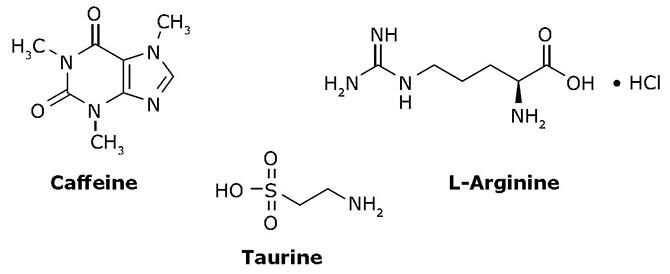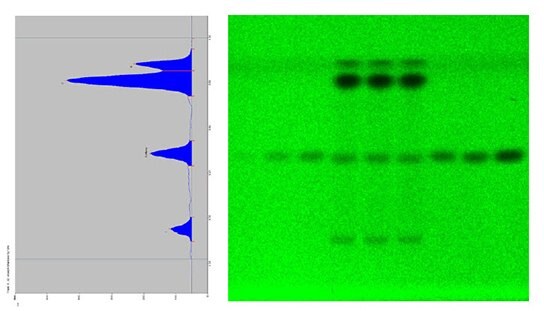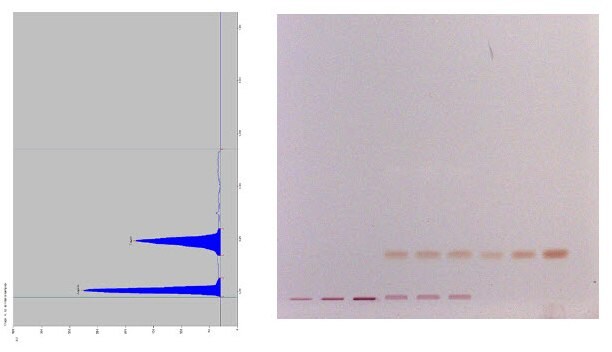Detection and Determination of Caffeine, Taurine and Arginine in Shampoos by HPTLC
Michaela Oberle1, Hans Griesinger1
Scientist Instrumental Analytics R&D

During the last few years a new trend in hair care products (shampoos) has become apparent. The cleaning ability of the product is no longer the primary focus as the cosmetic industry has started to develop products with additional features. Today, anti-dandruff shampoos or shampoos with repair capability are available in every supermarket. With slogans such as “anti-aging for hair”, “youthful hair”, “anti-hair loss system” or “hair energizer”, the cosmetics industry addresses customer needs. One of the reasons for this new focus might be a demographic change in the consumer society. The use of semi-natural additives also seems to be part of the trend. Therefore, there is a need for analytical methods to identify and to quantify these substances.
The application of modern thin-layer chromatography (TLC) offers advantages, especially in the field of cosmetics. Many samples can be analyzed quickly and simultaneously under exactly the same conditions. The ingredients usually can be separated directly from complex matrices and quantified. The separation of the typical cosmetics matrix components such as oils, fats and other components of the formulation is achieved by selecting the appropriate mobile phase, or if applicable, a TLC plate with concentrating zone. Straight forward coupling with other methods such as MS or NMR is also possible. Another advantage is the imaging evaluation, in which the results are presented as a picture and in some cases are self-explanatory.
Here the quantification of Caffeine and Taurine in shampoo is described by densitometry. The identity of arginine was detected by HPTLC-MS (data not shown). Since Arginine has not been moved from the starting point, a mobile phase optimization would be needed for precise quantification, which was not performed in this study due to time constraints.

TLC Conditions/Parameters
Sample and standard solutions
- 1 g of each shampoo sample was stirred with 10 mL of Isopropanol at room temperature and filtered with a 0.45 micron syringe filter.
- Standards: Solutions of Caffeine, Taurine and Arginine 1 mg/mL in Methanol
Layer
Sample application
- Band wise with Automatic TLC Sampler 4, band length 5 mm, distance between bands 10 mm, distance from the lower edge 10 mm, application volume 0.1 – 5 μL
Chromatography
- In a twin through chamber 10 x 10 cm (migration distance 50 mm) with Isopropanol – n-Heptane – Water 7:3:1 (v/v/v) for Caffeine and Isopropanol - Water 8:2 (v/v) for Arginine and Taurine.
Derivatization (only Arginine and Taurine)
- Spraying with Ninhydrin reagent (Cat. No. 1.06705.0100)
Documentation
- With DigiStore 2, Caffeine chromatogram (without derivatization) under UV 254 nm; Arginine/Taurine chromatogram (after derivatization) under white light.
Densitometry
- With TLC Scanner 3, Caffeine chromatogram (without derivatization) with adsorption measurement at UV 254 nm; Arginine/Taurine chromatogram (after derivatization) with adsorption measurement at 600 nm (slit dimension 4 x 0.3 mm, scanning speed 20 mm/s)
Results and Discussion
Caffeine could be identified with a hRF- value of 54. The quantification using peak areas resulted after triple determination of the shampoo sample 1, and 6 point calibration to an average content of the target substance of 94 mg/g shampoo (track 4: 90 mg, track 5: 91 mg, and track 6: 100 mg), based on the amount in the cosmetic formulation. Quantification was made using the polynomial regression based on the peak area (r = 0.99906, sdv = 3.94%). The amount of caffeine found corresponds to the commonly present amount of 0.1% active ingredient in a formulation.

Figure 1.Scan of track 5 and picture of the whole plate at UV 254 nm
Taurine and Arginine: The plate was derivatized with ninhydrin spray solution and documented under white light. Arginine was not moved under these chromatographic conditions. Taurine could be identified with a hRF value of 24. The quantification of the peak areas by triple determination of the shampoo sample 2 and a 3 point calibration resulted in an average for the content of taurine of 75 mg/g shampoo (track 4: 72 mg, track 5: 77 mg, track 6: 75 mg, CV = 2.971, n = 3), based on the amount of cosmetic formulation. This corresponds to the usual amount of 0.1% active ingredient in a formulation. Since arginine has not been moved from the starting point, a mobile phase optimization would be needed for precise quantification, which was not performed in this study due to time constraints.

Figure 2.Scan of track 6 at 600 nm and picture of the whole plate after derivatization under white
Conclusion
The above presented data demonstrates that HPTLC can be used to determine caffeine and taurine in a shampoo matrix. With further method adjustments also arginine potentially can be quantified. In conclusion this study demonstrates that HPTLC is a viable & reliable tool for efficient & economic analysis of active ingredients in cosmetic samples, that typically contain a high matrix load.
Per continuare a leggere, autenticati o crea un account.
Non hai un Account?